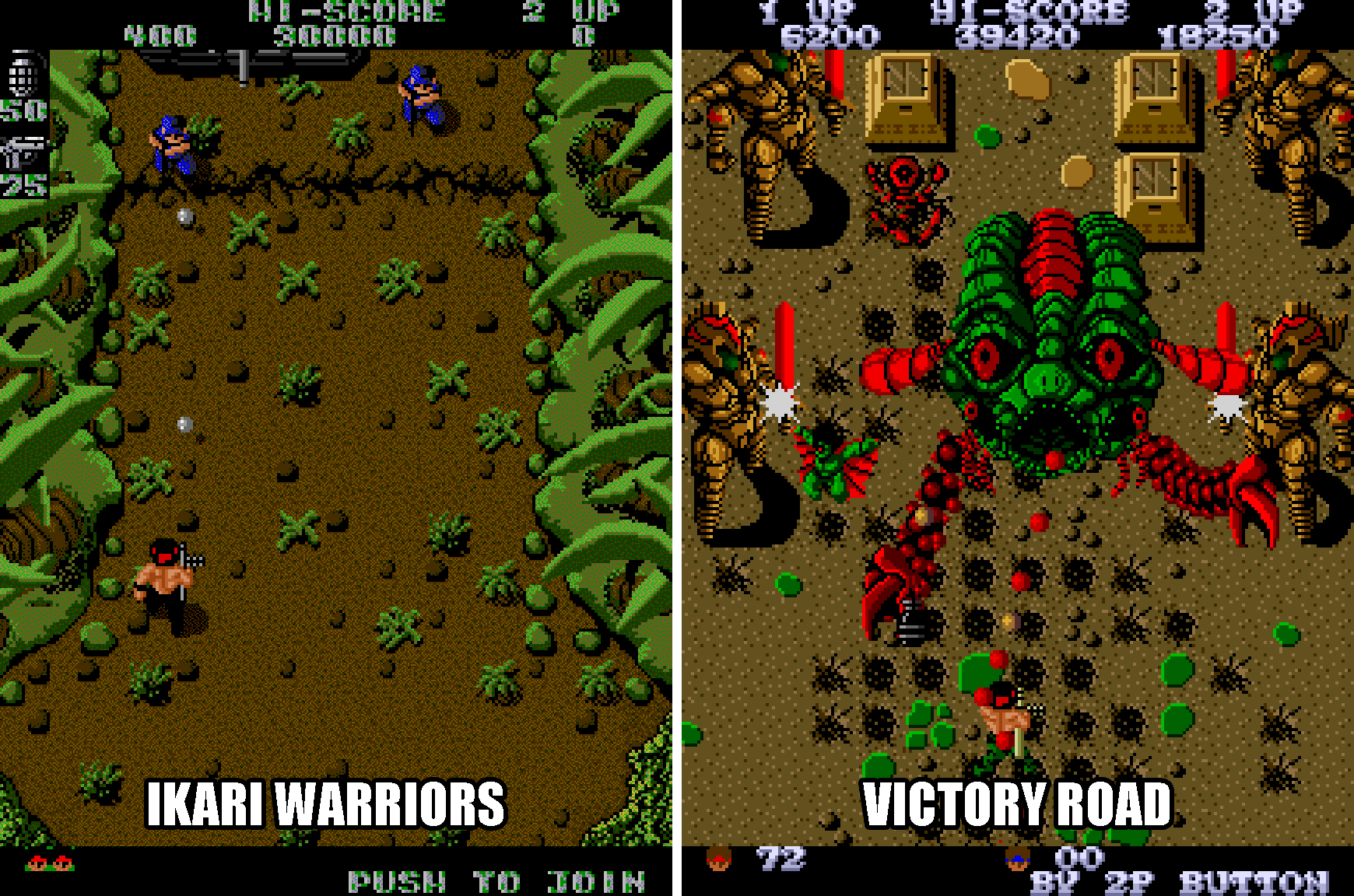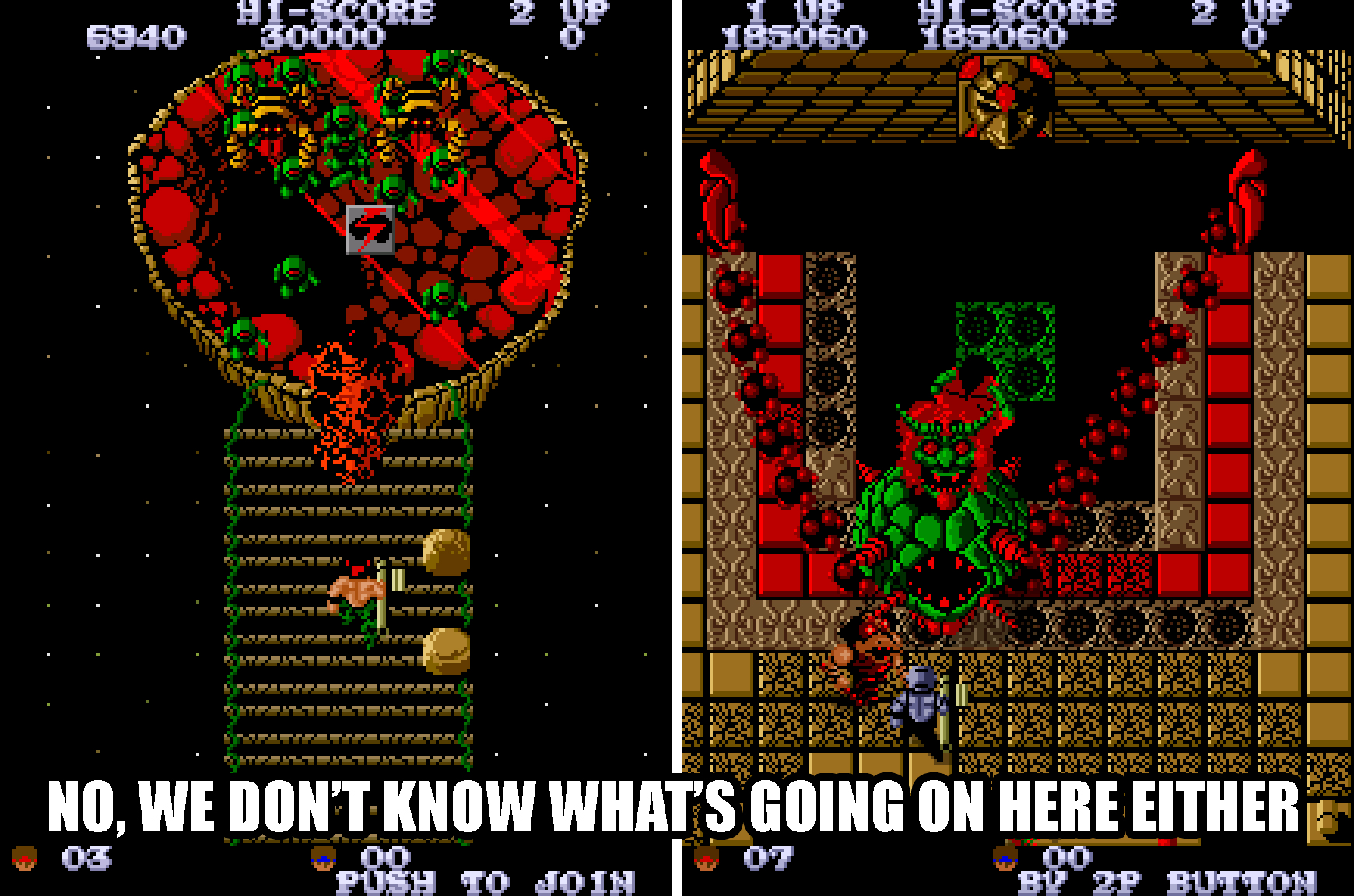Victory Road: One of the Weirdest Video Game Sequels of All Time
It was the sequel to the military shooting game, Ikari Warriors. So why was Victory Road so weird?
Cast your minds back to the year 2004, and the release of Infinity Ward’s shooter, Call Of Duty. With its authentic-feeling locations, characters and sound effects, it captured at least a bit of the grime and grip of real-world combat. The 2005 sequel was an even bigger hit – generally praised for its intensity and gritty realism.
But imagine, just for a moment, an alternate universe where Call Of Duty 2 emerged as a completely different game. Imagine how strange it would be if, for some reason, developer Infinity Ward decided to set Call Of Duty on an alien planet. Imagine if they’d thrown in some really surreal monsters instead of World War II soldiers. Imagine if, just to confuse everybody further, they didn’t even bother calling if Call Of Duty 2, but, say, Cabbage Fountain.
Incredibly, this is pretty much what happened in 1986.
In February that year, Japanese developer SNK released what’s widely regarded as its first worldwide hit: the top-down shooter, Ikari Warriors. A twist on Capcom’s earlier, military-themed Commando, Ikari Warriors brought its own twist to the run-and-gun action: the arcade cabinet was armed with an unusual kind of joystick that allowed the player to shoot in one direction while moving in the other – a handy tactical advantage as enemy soldiers flooded the screen from every direction.
Ikari Warriors introduced other ideas of its own, too, including a welcome two-player co-op mode and a range of vehicles to commandeer, including tanks and helicopters. In many ways, Ikari Warriors was a product of its time: with their shock of long black hair, bare chests, and colored bandanas, the game’s heroes (Ralf and Clark) are clearly modelled on Sylvester Stallone’s title character in Rambo: First Blood Part II.
Unlike SNK’s earlier coin-op titles, which it had quietly been putting out in Japan since the late 1970s, Ikari Warriors was released all over the world and widely ported to home systems, including the NES and ZX Spectrum. It was this game, and to a lesser extent titles like Athena and Psycho Soldier, that helped build SNK’s global reputation – later, the firm would become best known for the Neo-Geo system and games like King Of Fighters and Metal Slug.
Read the latest Den of Geek Special Edition Magazine Here!
In 1986, meanwhile, SNK was evidently keen to capitalize on the success of Ikari Warriors, since it managed to rush a sequel into Japanese arcades by that October. Whether it was a by-product of a hurried development or simply the result of eating too much cheese at bedtime, that sequel proved to be startlingly weird.

First, let’s get the title out of the way. In the west, it was called Victory Road; in Japan, its title was Dogo Soken, which apparently means Bellowing Atmosphere.
Then there’s the plot. It picks up immediately after the events of Ikari Warriors, as Ralf and Clark are flying home from their last adventure: one minute they’re high-fiving each other for a successful mission, and the next they’re struck by an electrical storm that flings them into the future.
Mechanically, Victory Road is pretty much the same as its predecessor: the same run-and-gun action, the same rotary joystick, and more than likely, a fair bit of the same code underpinning the game behind the scenes. What distinguishes Victory Road is its descent into dreamlike surrealism – there are moments in here that rival John Boorman’s 1970s cinematic odyssey, Zardoz.
Take the absolutely maniacal opening. Our brave warriors are working their way along what looks like a gigantic rope bridge (like the one out of the Temple Of Doom) suspended in the depths of space. Suddenly, an outsized, disembodied stone head descends, and screams the following:
“Warriors! Show some guts! You can’t escape me! Come get me if you can!”
Cackling villainously, the giant stone head then floats back up the screen, and the real challenge begins. Tiny green critters come scuttling down the rope bridge, and make odd squeaking noises when they’re shot. Next come bouncing, four-legged spider-wasp hybrids. After that, flying green demons with red wings; the onslaught is bizarre and relentless.
As Ralf and Clark venture further into the game, the rope bridges give way to sandy areas with alien stone structures and ancient-looking columns. There are gigantic area bosses that take the form of three-headed dragons and giant crabs with extending pincers. Through it all, the synth score is largely drowned out by the plaintive squeals of enemies, the rumble of explosions, sirens, and regular Stallone-style grunts from the heroes.
Hilariously, as outlandish as the action in Victory Road is, the central characters still retain their bare-chested look from Ikari Warriors. It’s like taking Rambo out of his natural battlefield environment and putting him in the midst of, say, Valerian, and seeing how he responds to all the alien creatures shuffling about everywhere. It stands to reason that Rambo would probably just blow everything up with a bazooka.
In many ways, Victory Road sums up what was great about the Japanese games industry in its formative years. Today, the notion of making such an outlandish sequel would be turned down flat by executives in expensive suits; back then, there was nobody to tell SNK that following a military action game with giant heads, time vortexes and flying green space demons was going to just confuse everybody.
With the Call Of Duty series, the evolution from quasi-realistic World War II shooter to contemporary action blockbuster with sci-fi elements (2016’s Infinite Warfare) took more than a decade. Ikari Warriors basically went from military shooter to febrile madness in approximately eight months.

Victory Road appears to have been a success, since it was almost as widely ported to home computer consoles as Ikari Warriors was. All the same, SNK may have known that they went a bit far down the surrealism route with Victory Road, since 1989’s Ikari Warriors III: The Rescue went for a more conventional approach. The president’s kid has been kidnapped and only you can save them with your brawn and bullets – the rest basically writes itself.
Ikari Warriors III may have restored order to the universe, but we can’t help but harbor a sneaking affection for Victory Road – especially the original arcade version. When the game’s running at full bore and the bullets are flying, the effect is hypnotic: a cacophonous, colorful rave of a shooter that’s low on strategy but high on eye-popping action.
Best of all, there’s very little explanation as to what it is you’re killing or why – at least until the end. Part of the concluding text crawl reads as follows:
“You have fighted well to the last stage. Thanks. All devils have gone to the world where they should stay.”
With the devils apparently expelled, Ikari Warriors reverted back to its military theme for its third and final entry. Thereafter, Ralf and Clark retired from the battlefield altogether, and appeared among the roster of characters in SNK’s King Of Fighters. In a way, we can’t help wishing SNK hadn’t expelled their devils; the company never made another game quite as mad as this one again, even as the ’90s saw them reach the height of their creative powers.
Run-and-gun shooter Shock Troopers, released in 1997, was in many ways a spiritual successor to Ikari Warriors. Regrettably, it sorely lacked Victory Road‘s madness – or giant, talking stone heads.